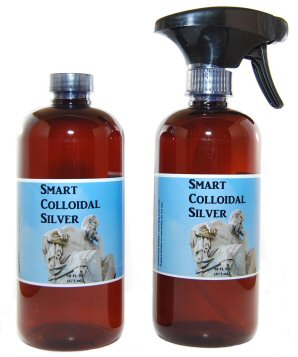Silver is a natural antimicrobial which kills bacteria, viruses, fungi/yeasts, molds and protozoa parasites
Smart Colloidal Silver Ingredients
-
30+ppm of 99.9+% Silver Nanoparticles & Ions
-
Steam Distilled Water
Nothing else added to speed up the process or suspend more silver.
Just the facts
30+ppm of silver?
Yes, this is what we guarantee. The product is occasionally tested by an outside lab using elemental spectroscopy with 0.2ppm accuracy for silver. The lab reports consistently show about 40ppm elemental silver. The slight variation in ppm causes the new product color darkness to vary a bit, but always exceeding the guarantee.
Our spectroscopy analysis is completely different from TDS (total dissolved solids) measurements which are frequently used by other "colloidal silver" manufacturers. TDS is very inaccurate for silver ion concentration. Furthermore, TDS measurements have very little relationship, if any, to the silver nanoparticle concentration.
For a higher concentration of silver in a very localized place, consider using our 150ppm Silver Lip Balm or 500ppm Silver Cream.
Why 99.9+% minimum silver purity, instead of 99.99%?
Like our product, our silver supplier has a guaranteed minimum which they exceed to assure 100% conformance. The difference between 99.9% and 99.99% is one part per thousand. Applying this worst-case difference to 30ppm (parts per million) allows a contamination contribution less than 30 parts per billion.
Acquiring 99.99% pure silver in the configuration needed for our proprietary process would cost far more and only result in an insignificant quality improvement. Instead, we choose to provide you with a high quality product with a better product value.
Silver Nanoparticles & Ions?
Silver nanoparticles give the product its color. As the The yellow color indicates the smallest nanoparticles (other products have an amber to brown color as the nanoparticle size increases). The yellow color is darker as the nan-particle concentration increases.
Silver ions are colorless. They're the primary silver component of clear products properly known as ionic silver which often claim to be "colloidal silver". Without enough silver nanoparticles for at least a light coloration, its not real colloidal silver.
This product has a nice yellow color indicating a high concentration of the smallest nanoparticles. ike all real colloidal silver products, it also contains silver ions.
Why steam distilled water?
Properly steam distilled water is purer than nearly all deionized water. The distilling process removes all of the contaminates that contain ions, leaving virtually none. Overall, properly distilled water is usually a much better choice.
However, not all distilled water is created equally. The most common problem is added filtration after distilling which often introduces contaminates. If not properly pre-filtered and lower evaporation temperature contaminates purged from the steam, water feedstock contaminates can enter the distilled water.
Any significant water contamination will cause the colloidal silver to change color. It may even become clear after the nanoparticles settle out or plate inside the container. It took a couple of years to find a good distilled water source with the consistent purity needed to avoid discoloration when the product is properly dispensed and stored.
Our distilled water is virtually as pure as laboratory reagent water, but at only a small fraction of the cost to provide you with high quality and a better value.
Nothing else added?
Making real colloidal silver with a yellow color having the smallest and most effective nanopartlcles takes a long time. For example, our proprietary process takes 15-days with only silver and distilled water. Some products speed up and/or simplify the process to lower the manufacturing cost with a variety of added contaminants which are not found in real colloidal silver, such as: iodides, nitrates, phosphates, salts or chlorides.
Protein or polymer contaminants are added to some "colloidal silver" products to suspend more and larger silver particles. These are known as silver protein products and have a color ranging from yellow to amber to brown to red with increasing nanoparticle size. Proteins or polymers coat the silver particles, partially isolating them from their surroundings for less contact and effectiveness. Microbes can actually feed on these additives as long as they can avoid contacting the isolated silver particles. Products with these additives are not real colloidal silver, regardless of their color and far higher ppm of silver.


